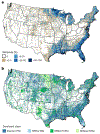National hydrologic connectivity classification links wetlands with stream water quality
- PMID: 37389401
- PMCID: PMC10302404
- DOI: 10.1038/s44221-023-00057-w
National hydrologic connectivity classification links wetlands with stream water quality
Abstract
Wetland hydrologic connections to downstream waters influence stream water quality. However, no systematic approach for characterizing this connectivity exists. Here using physical principles, we categorized conterminous US freshwater wetlands into four hydrologic connectivity classes based on stream contact and flowpath depth to the nearest stream: riparian, non-riparian shallow, non-riparian mid-depth and non-riparian deep. These classes were heterogeneously distributed over the conterminous United States; for example, riparian dominated the south-eastern and Gulf coasts, while non-riparian deep dominated the Upper Midwest and High Plains. Analysis of a national stream dataset indicated acidification and organic matter brownification increased with connectivity. Eutrophication and sedimentation decreased with wetland area but did not respond to connectivity. This classification advances our mechanistic understanding of wetland influences on water quality nationally and could be applied globally.
Conflict of interest statement
Competing interests The authors declare no competing interests.
Figures



References
-
- Ghermandi A, van den Bergh JCJM, Brander LM, de Groot HLF & Nunes PALD Values of natural and human-made wetlands: a meta-analysis. Water Resour. Res 46, W12516 (2010).
-
- Comer P et al. Biodiversity values of geographically isolated wetlands in the United States NatureServe; https://www.natureserve.org/sites/default/files/biodiversity_values_of_g... (2005).
Grants and funding
LinkOut - more resources
Full Text Sources
